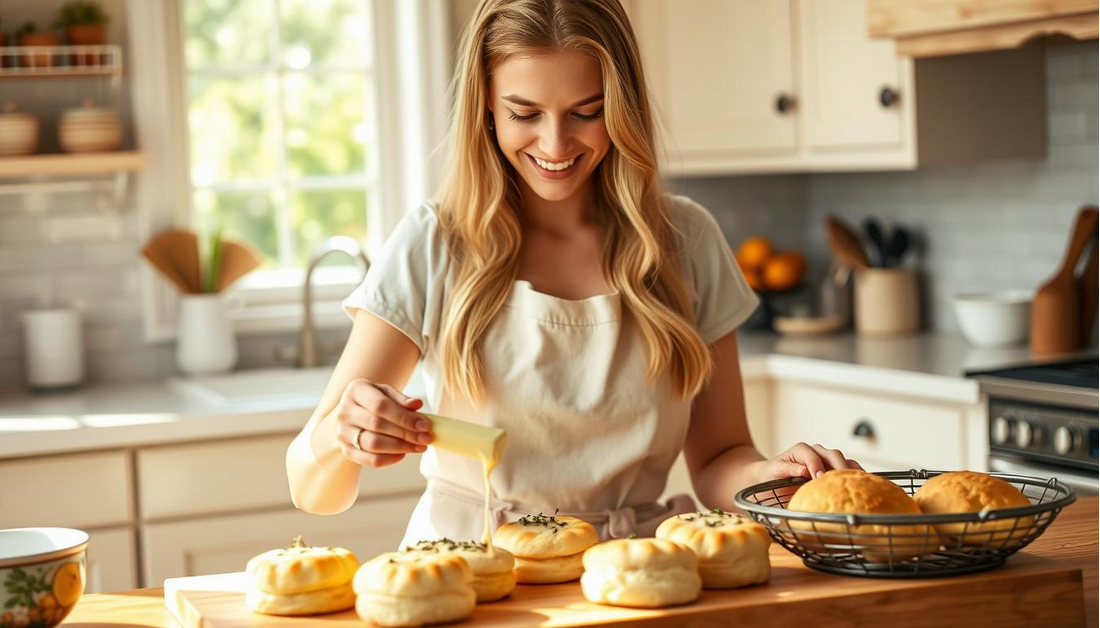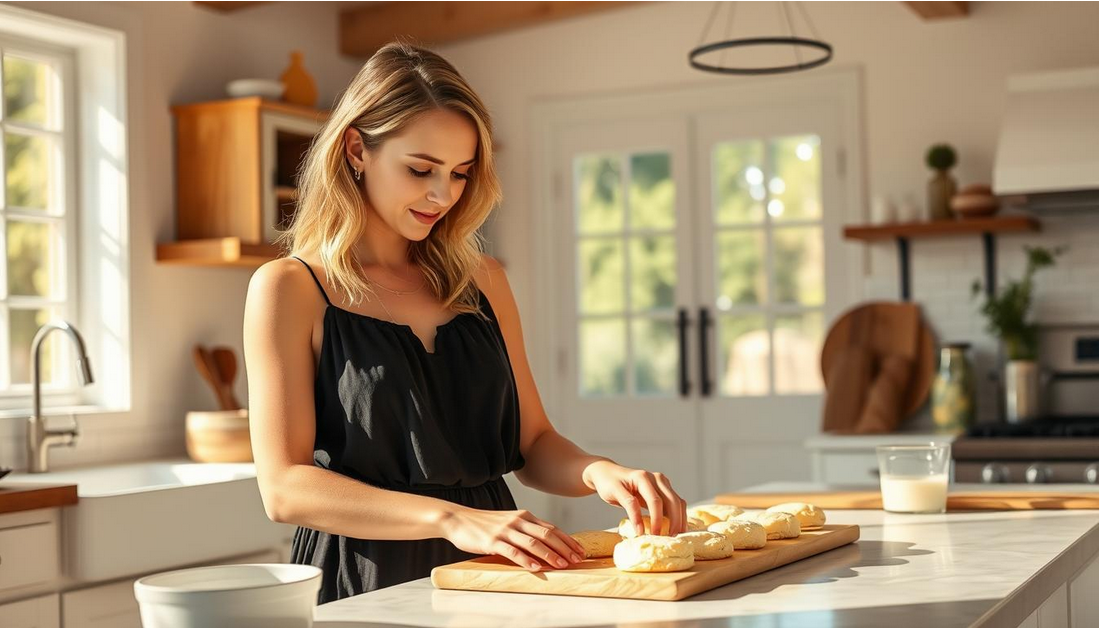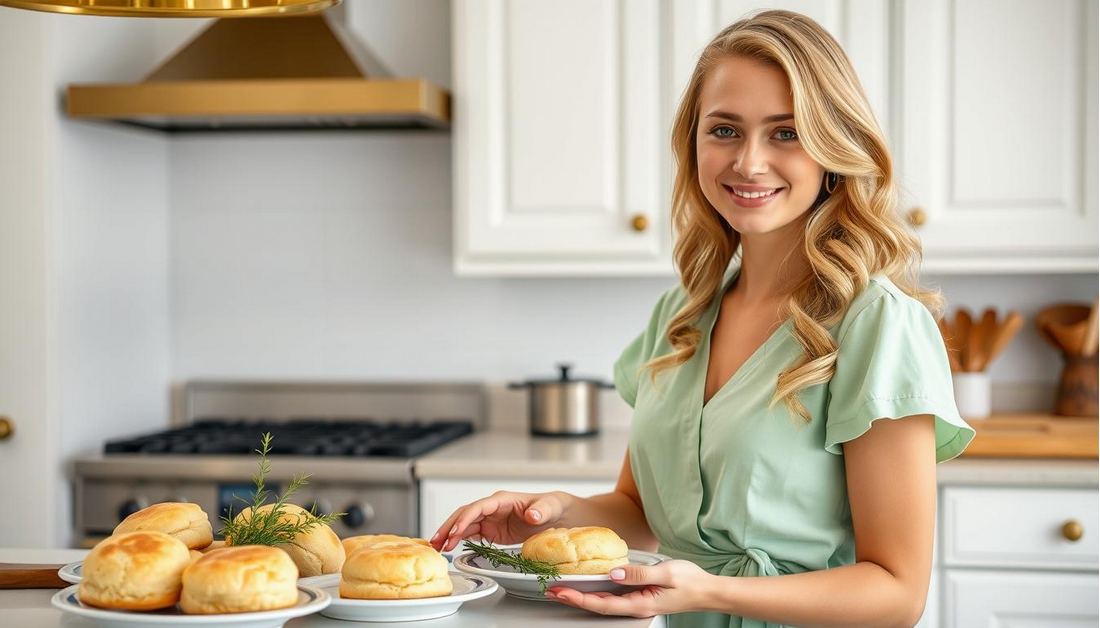India customers to view on amazon.in
Buttermilk Biscuits with Herb Butter Bliss
Welcome to the world of homemade biscuits, where the tender, flaky texture meets the rich, savory flavor of herb-infused butter. Imagine starting your day with a warm, golden-brown biscuit, perfectly paired with a pat of herb butter that elevates your breakfast or brunch to a new level.

The heritage of Southern biscuits is rooted in tradition, and the magic of buttermilk is a key ingredient that gives these biscuits their signature taste and texture. In this article, we’ll explore how to create the perfect fluffy biscuits recipe from scratch.
Key Takeaways
- Learn the secret to making tender and flaky homemade biscuits.
- Discover the magic of herb-infused butter for your biscuits.
- Understand the importance of buttermilk in Southern biscuit recipes.
- Get a simple recipe to make fluffy biscuits from scratch.
- Explore the perfect pairings for your herb butter biscuits.
The Southern Heritage of Flaky Buttermilk Biscuits
The tradition of buttermilk biscuits is deeply rooted in Southern culture, where baking is not just about sustenance, but a way of life. This beloved baked good has been a cornerstone of Southern cuisine, with its rich history and cultural significance woven into the fabric of everyday life.

A Brief History of American Biscuit Tradition
American biscuits have a storied past that dates back to early European settlers, who brought their baking traditions to the New World. Over time, these recipes evolved, influenced by local ingredients and cultural exchange. The Southern United States became a hub for biscuit-making, with buttermilk emerging as a key ingredient that gave biscuits their characteristic flakiness and flavor.
The history of biscuits in America is also marked by the influence of African and Native American cuisines, which introduced new ingredients and cooking techniques. This blending of cultures resulted in the distinctive Southern-style biscuits we know and love today.
The Magic of Buttermilk in Southern Baking
Buttermilk is the secret ingredient that elevates Southern biscuits to new heights. Its acidity reacts with baking soda to produce a tender, flaky texture that is both delicious and visually appealing. The tangy flavor of buttermilk also adds depth to the biscuits, making them a perfect accompaniment to a wide range of dishes, from breakfast staples to dinner entrees.
The use of buttermilk in Southern baking is a testament to the resourcefulness of home cooks, who utilized the ingredients available to them to create something truly special. Today, buttermilk remains an essential component of traditional Southern biscuit recipes.
Essential Ingredients for Perfect Homemade Biscuits
Creating perfect homemade biscuits starts with understanding the essential ingredients that make them flaky and delicious. The quality of these ingredients directly impacts the final product, making it crucial to choose wisely.
Flour Selection: All-Purpose vs. Self-Rising
The type of flour used is fundamental in biscuit making. All-purpose flour is a versatile choice, suitable for a variety of baked goods. However, self-rising flour is often preferred for biscuits as it contains baking powder and salt, simplifying the recipe and ensuring consistent rise.
| Flour Type | Characteristics | Biscuit Outcome |
|---|---|---|
| All-Purpose Flour | Versatile, neutral flavor | Requires additional leavening agents |
| Self-Rising Flour | Contains baking powder and salt | Easier to make consistent, fluffy biscuits |
Real Buttermilk vs. Quick Homemade Substitutes
Buttermilk is a key ingredient that contributes to the tenderness and flavor of biscuits. While real buttermilk is ideal, a substitute can be made by mixing milk with vinegar or lemon juice, offering a similar acidity.

The Importance of Cold, High-Quality Butter
Cold, high-quality butter is essential for creating the flaky layers in biscuits. The cold temperature ensures that the butter remains solid, creating steam during baking and resulting in a layered texture.
By focusing on these essential ingredients and their roles, bakers can significantly improve their homemade biscuit recipes, achieving a deliciously flaky and tender result.
Kitchen Tools for Biscuit-Making Success
The journey to perfect biscuits begins with the right equipment in your kitchen. Having the appropriate tools not only simplifies the process but also significantly enhances the quality of your easy biscuits. Let’s explore the essentials that will help you achieve biscuit-making success.
Essential Mixing and Cutting Equipment
To start, you’ll need a few fundamental tools. A large mixing bowl is necessary for combining your ingredients. A pastry blender or your fingertips are crucial for cutting the butter into the flour mixture, creating the flaky layers characteristic of no-knead biscuits. Additionally, a sharp biscuit cutter or the rim of a glass is required to cut out your biscuits.
Cast Iron Skillets: The Secret to Perfect Biscuits
A cast iron skillet is a valuable asset for baking biscuits. It distributes heat evenly, ensuring your biscuits are cooked consistently. Preheating the skillet in the oven before adding your biscuits can enhance the crust, giving it a golden brown finish. This method is particularly effective for achieving the perfect cast iron biscuits.
Optional Tools That Elevate Your Baking Game
While not essential, certain tools can make the biscuit-making process more efficient. A dough scraper can help in handling the dough, and a baking sheet lined with parchment paper can simplify cleanup. For those looking to get serious about their biscuit game, investing in a biscuit stamp or a bench scraper can be beneficial.

Mastering the No-Knead Biscuit Technique
Mastering the no-knead biscuit technique is a game-changer for home bakers seeking tender, flaky biscuits. This method simplifies the biscuit-making process while maintaining the quality and texture that makes biscuits a beloved staple in many cuisines.
The Cold Ingredients Method for Flaky Layers
The key to achieving flaky layers in no-knead biscuits lies in using cold ingredients. Keeping your butter and buttermilk chilled is crucial, as this slows down the gluten development, resulting in a tender, layered texture. Ensure that your butter is cubed and refrigerated until you’re ready to mix your dough.

Gentle Mixing: Why Less Handling Creates Better Biscuits
Gentle mixing is a critical step in the no-knead biscuit technique. Overmixing can lead to tough biscuits, so it’s essential to combine your ingredients just until they come together in a shaggy dough. Avoid overworking the dough, as this will develop the gluten and result in a less tender biscuit.
The Folding Technique for Creating Buttery Layers
The folding technique is a simple yet effective way to create the buttery layers that make biscuits so delicious. By gently folding the dough a few times during the mixing process, you can create multiple layers of butter and dough, resulting in a flaky, tender biscuit.
Proper Cutting and Spacing for Maximum Rise
Proper cutting and spacing of your biscuits are crucial for achieving maximum rise. Use a sharp cutter to cut out your biscuits, and make sure to space them evenly on your baking sheet. This will allow for even rising and prevent the biscuits from spreading into each other.
By mastering these techniques, you’ll be well on your way to creating delicious, flaky no-knead biscuits that are sure to impress. Whether you’re a seasoned baker or just starting out, the no-knead method offers a straightforward path to achieving buttery biscuit bliss.
Buttermilk Biscuits with Herb Butter Bliss: Complete Recipe
Now that we’ve covered the fundamentals, let’s dive into the complete recipe for Buttermilk Biscuits with Herb Butter Bliss. This recipe combines the flaky, tender goodness of Southern-style buttermilk biscuits with the rich, aromatic flavor of homemade herb butter.
Preparing Your Biscuit Dough fr

om Scratch
To start, preheat your oven to 425°F (220°C). In a large mixing bowl, whisk together 2 cups of all-purpose flour, 4 teaspoons of baking powder, 1 teaspoon of salt, and 1 tablespoon of granulated sugar. Add 1/2 cup of cold, cubed butter to the dry ingredients and use a pastry blender or your fingertips to work the butter into the mixture until it resembles coarse crumbs.
Pour in 3/4 cup of buttermilk and gently fold the mixture until it forms a shaggy dough. Be careful not to overmix, as this can lead to tough biscuits.
Shaping and Baking Your Southern-Style Biscuits
Turn the dough out onto a floured surface and gently knead it a few times until it comes together. Roll the dough out to a thickness of about 1 inch (2.5 cm) and use a biscuit cutter or the rim of a glass to cut out your biscuits. Gather the scraps, re-roll the dough, and cut out additional biscuits.
Place the biscuits on a baking sheet lined with parchment paper, leaving about 1 inch of space between each biscuit. Brush the tops with a little extra melted butter for a golden finish.
Timing and Visual Cues for Perfect Doneness
Bake the biscuits in the preheated oven for 12-15 minutes, or until they’re golden brown on top. Keep an eye on them after 10 minutes, as oven temperatures can vary. The biscuits are done when they’re lightly browned and firm to the touch.
While the biscuits are baking, prepare your homemade herb butter by mixing softened butter with chopped fresh herbs like parsley, chives, or thyme. Once the biscuits are done, let them cool for a few minutes before serving with the herb butter.
Creating Savory Herb-Infused Butter Spreads
Discover the secret to making savory herb-infused butter spreads that complement your freshly baked buttermilk biscuits. Herb-infused butter is a versatile and flavorful addition to many dishes, and when paired with buttermilk biscuits, it creates a truly unforgettable culinary experience.
Fresh Herbs That Complement Buttermilk Biscuits
The choice of herbs can significantly impact the flavor profile of your herb butter. Popular herbs that complement buttermilk biscuits include chives, parsley, dill, and thyme. Each of these herbs brings a unique freshness that enhances the richness of the butter.
For a more complex flavor, consider combining herbs. For example, a mix of chives and parsley can add both onion-like flavor and freshness. Experimenting with different herb combinations allows you to create a signature herb butter that suits your taste.

Step-by-Step Herb Butter Preparation
Preparing herb butter is a straightforward process that requires just a few ingredients: softened butter, fresh herbs, and a bit of salt. Begin by finely chopping your chosen herbs. The amount can vary based on your preference for herb intensity.
Mix the chopped herbs into softened butter, adding a pinch of salt to enhance the flavors. Blend until the herbs are evenly distributed throughout the butter. Taste and adjust the seasoning as needed.
| Herb | Flavor Profile | Pairing Suggestion |
|---|---|---|
| Chives | Mild onion flavor | Pairs well with breakfast dishes |
| Parsley | Fresh, green flavor | Complements most savory dishes |
| Dill | Bright, slightly tangy | Ideal for fish or pickled dishes |
| Thyme | Earthy, slightly minty | Suits roasted meats and vegetables |
Make-Ahead and Storage Tips for Herb Butter
Herb butter can be made ahead and stored in the refrigerator for up to a week or frozen for longer storage. To freeze, shape the herb butter into a log, wrap it tightly in plastic wrap, and slice as needed.
When storing, keep the herb butter in an airtight container to preserve freshness. Label the container with the date and contents for easy identification.
Serving Your Fluffy Buttermilk Biscuits
Now that you’ve mastered the art of making fluffy buttermilk biscuits, it’s time to explore the perfect ways to serve them. Your freshly baked biscuits and accompanying herb butter are sure to impress, whether you’re hosting a breakfast gathering or a dinner party.
Breakfast and Brunch Pairing Ideas
Start your day with a delicious breakfast or brunch featuring your fluffy biscuits. Pair them with scrambled eggs, crispy bacon, or sausage gravy for a hearty meal. For a lighter option, serve with fresh fruit and whipped cream or a dollop of clotted cream. The versatility of buttermilk biscuits makes them an ideal base for various breakfast and brunch dishes.
Dinner Accompaniments and Meal Inspirations
Fluffy buttermilk biscuits aren’t just for breakfast; they can complement dinner beautifully. Serve them alongside your favorite soups, stews, or chili for a comforting meal. They also pair well with roasted meats, such as chicken or beef, and can be used to soak up savory gravies. For a Southern-inspired dinner, consider serving biscuits with fried chicken or barbecue.

Creating a Biscuit Bar for Entertaining Guests
Impress your guests by setting up a biscuit bar with various toppings and spreads. Offer a selection of herb butters, jams, honey, and other sweet and savory options. You can also include meats like bacon or sausage for added protein. This interactive dining experience allows guests to customize their biscuits to their liking, making it a fun and memorable way to entertain.
Delicious Variations on Classic Buttermilk Biscuits
The classic buttermilk biscuit recipe is just the beginning; numerous variations can cater to diverse tastes and dietary needs. By incorporating different ingredients and techniques, you can create a wide range of biscuits suitable for various occasions and preferences.
Sweet Adaptations for Breakfast and Dessert
Transform your buttermilk biscuits into sweet treats by adding ingredients like dried cranberries, orange zest, or cinnamon. These sweet biscuits are perfect for breakfast or as a dessert when paired with honey or fruit preserves. You can also create a streusel topping with butter, sugar, and flour for an extra crunchy texture.
Savory Add-Ins for Enhanced Flavor Profiles
For savory biscuits, consider adding grated cheese, diced jalapeños, or fresh herbs like chives or rosemary. These add-ins can enhance the flavor profile of your biscuits, making them ideal for accompanying soups, stews, or as a side to your favorite main dishes. The key is to balance the flavors so that the add-ins complement the buttermilk biscuit’s natural taste.
Dietary Modifications for Special Needs
To accommodate dietary restrictions, you can modify the classic recipe to create gluten-free or vegetarian biscuits. Use gluten-free flour blends for those with gluten intolerance, and ensure that your butter or other ingredients are suitable for vegetarians. These modifications allow everyone to enjoy the delightful taste of homemade buttermilk biscuits.
| Variation Type | Ingredients to Add | Suitable For |
|---|---|---|
| Sweet | Dried cranberries, orange zest | Breakfast, dessert |
| Savory | Grated cheese, diced jalapeños | Soups, stews, main dishes |
| Dietary Modification | Gluten-free flour, vegetarian butter | Gluten-free, vegetarian diets |

Storing, Freezing, and Reheating Your Homemade Biscuits
The key to savoring your freshly baked biscuits beyond the day they’re made lies in effective storage and reheating methods. Properly handling your biscuits after they’ve cooled can make all the difference in maintaining their freshness and flavor.
Keeping Biscuits Fresh After Baking
To keep biscuits fresh after baking, store them in an airtight container at room temperature. It’s crucial that the biscuits are completely cool before storing to prevent moisture buildup, which can lead to sogginess. For short-term storage, up to two days, a paper bag or a breathable container can also be used, but be aware that biscuits may become stale faster.
Freezing Unbaked and Baked Biscuits
Freezing is an excellent way to extend the life of your biscuits. For unbaked biscuits, place them on a baking sheet lined with parchment paper and freeze until solid. Then, transfer them to a freezer-safe bag or container. Baked biscuits can also be frozen directly in a freezer-safe bag or container. In both cases, be sure to label with the date and contents.
Best Methods for Reheating Without Drying Out
Reheating biscuits can be done in the oven or microwave. For oven reheating, preheat to 350°F (175°C), wrap biscuits in foil, and heat for 5-10 minutes. For microwave reheating, wrap biscuits in a damp paper towel to maintain moisture and heat for 20-30 seconds. Be cautious not to overheat, as this can dry out the biscuits.
| Storage Method | Duration | Reheating Tip |
|---|---|---|
| Room Temperature | Up to 2 days | Oven reheating |
| Freezer | Up to 2 months | Microwave or oven reheating |
Conclusion: Enjoying Your Buttery Biscuit Bliss
Mastering the art of making Buttermilk Biscuits with Herb Butter Bliss is a rewarding experience that brings the warmth of Southern tradition into your kitchen. As you’ve learned throughout this article, creating the perfect homemade biscuits involves a combination of quality ingredients, precise techniques, and a touch of creativity.
The joy of enjoying biscuits fresh from your oven, slathered with rich herb butter, is a simple pleasure that elevates any meal. Whether you’re serving them alongside a hearty breakfast, using them to sop up savory gravy at dinner, or simply enjoying them on their own, the delight of buttery biscuit bliss is undeniable.
As you continue to refine your buttermilk biscuit recipe, remember that practice makes perfect. Don’t be discouraged by initial attempts – each batch will bring you closer to achieving the flaky, tender biscuit bliss you’re striving for. So, keep mixing, rolling, and baking, and soon you’ll be savoring the delicious rewards of your labor.
FAQ
What is the best type of flour to use for making buttermilk biscuits?
All-purpose flour is a popular choice for making buttermilk biscuits, but you can also use self-rising flour or a combination of all-purpose and cake flour for a tender, flaky texture.
Can I make buttermilk biscuits without real buttermilk?
While real buttermilk is ideal, you can make a substitute by mixing 1 cup of milk with 1 tablespoon of white vinegar or lemon juice. Let it sit for 5-10 minutes to thicken before using.
How do I keep my biscuits from becoming too dense or tough?
To avoid dense or tough biscuits, make sure to handle the dough gently, keep the ingredients cold, and don’t overmix the dough.
What’s the best way to store leftover biscuits?
Store leftover biscuits in an airtight container at room temperature for up to 2 days or freeze them for up to 2 months. Reheat frozen biscuits in the oven or microwave before serving.
Can I make herb butter ahead of time?
Yes, you can make herb butter ahead of time and store it in the refrigerator for up to 1 week or freeze it for up to 3 months. Bring it to room temperature before serving.
How do I achieve the perfect flaky layers in my biscuits?
To achieve flaky layers, use cold ingredients, handle the dough gently, and fold the dough multiple times during the rolling process.
Can I use other types of milk instead of buttermilk?
While you can experiment with other types of milk, buttermilk’s acidity and creaminess are essential for creating the characteristic tender, flaky texture of Southern biscuits.
What’s the best way to reheat frozen biscuits?
To reheat frozen biscuits, bake them in a preheated oven at 350°F (175°C) for 5-7 minutes or microwave them for 20-30 seconds, wrapped in a damp paper towel.







